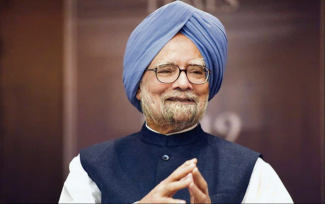The process of symbolizing political figures has significantly augmented with the rise of populist politics of our age. Since the past decade, consolidation of symbolic spaces is becoming particularly noticeable across different political circles. Theatrical and sometimes comical acts are performed by many a popular political leader of different nations, celebrating superhuman machoism for filling-up the void of symbolic space with interestingly captivating non-sense. This usurping of symbolic space has made it easy to create, divert, and wipe out public memory with advent of what I would call ‘technologies of political propaganda’. Such technologies have assisted in contextualizing, centering, and decentering public figures according to swings in political conditions, espousing for formations of political cults.
One figure that has stood out from the above modes of politicizing is that of Dr. Manmohan Singh. Although, the domain of history and historiography has never remained neutral of the political narratives, the question is how can a leader of his stature stand ignored in historical unfolding? To answer this perplexing question that has flabbergasted many in our times, we need to understand the forces of internal agency that build political narratives in populist politics. It is prudent at this point to draw distinction between few sub-categories of populist politics that help in understanding the role of a common agency of a centralizing political figure. Four sub-categories of populist politics can broadly be drawn here. First, politics based on addressal of economic hardships of modern-day working class, peasantry, and lower middle class; second, politics propounding conservative and racial ideology; third, ethno-religious politics of right wings and lastly, orthodoxically zealous religious politics of fringes. A common thread that ties all these forms of populist politics is that of emotional sensitivity around issues and creates a symbolic void demanding a filling by a messiah figure having mass appeal.
Delving further into the political process symbolizing political leaders in populist politics, let me refer to the thoughts of the political theorist Ernesto Lacalu’s enumerated in important work - On Populist Reason. For Lacalu, representation in democratic societies is a two-way process: “a movement from represented to representative, and a corelative one from representative to represented” (Lacalu, 2018, p. 158). Completing the loop at its origin a representative is not just a symbol or an idea personified in imaginative figure, but he is also an idea maker “who forces his followers to adjust themselves to what the representative does” (p. 160). Here Lacalu’s argument posits for a two-step process. In the first step, the representative is envisioned as a complete idea personified into the personhood of a representative. In the second step, the personhood of this representative unfolds into expression of an idea. This second step creates a fanatic dogma where everything that the representative does incites unquestionable reverence of the follower, because the idea and meaning is left to be discovered for its extra-territorial meaningfulness flowing from the being of a representative, a leader, a messiah, and so forth.
Empirically speaking, such leader becomes perceivable via insights presented in Hegel’s ‘Absolutization of Spirit’. Removing the personhood of leader from being an historical figure, an absolute leader that I would call symbolized leader, has the distinction of being both a form and an essence, transcending both existential and metaphysical domains. Such leader is there to be ‘realized, not analyzed’ by his followers. He belongs to his own being and is described by his own self and this contributes to his meta-human enunciation. Both thesis and antithesis belong to such leader. Therefore, religio-political figures are by and large revered in worldly domain because such figures acclaim a transcendental image in the followers’ mind. Populist politics adulate the oratory skills of such leaders, cognizing his words as sacrosanct. So, any critical mediation on political actions of symbolized leader, regardless of the which community entails in doing so, induces a sense of absolute horror in his followers’ mind. Such mediation prompts melancholy, resentment, and sometimes even violent rage amongst the followers. From a parallax view, critical mediation into worldly actions of the symbolized leader is politically imperative to fortify his stature.
In contrast with the aforesaid parochial model of symbolic leadership, Dr. Manmohan Singh exuded the paradigm of meta – symbolism via his uniquely personal leadership philosophy during the course of history. Relying on his actions in history to speak for themselves, he remained nonchalant about oratory rhetoric, was disinclined towards delivering passionate speeches, and remained steadfast while being facetiously trolled for his mute stances (being Maun). This style of leadership remains to be realized in theoretical and historical terms, especially by his own community including Sikhs. No headlines regarding his humble backgrounds caught attention in broad section of media. Propaganda machinery failed to discuss his foresightedness and contributions on real issues throughout his political career. His contributions in leading the country out of economic imbroglio and eventually pulling millions of his countrymen out of poverty expressed his devotion towards human life, which stood ignored in public imagination. Perhaps his relationship with power stands eclipsed in theoretical and critical understandings of our age.
Dr. Singh’s relationship with power, in certain ways, was never absolutist. Perhaps, this was a core reason for propagandas of ‘weak leadership’ publicized against him. To him, power invited a responsibility, a Maryada, a sense of duty, than a mere agency of self-aggrandization, self-edification or assertion of individual and collective ego. Absolute relationship with raw power becomes superfluous, self-absorbed being-in-itself, and self-possessive, reflecting a pseudo-image that one perceives and desires for one’s own self. So, despite being sabotaged, both by opposition and many times by his own party members who created an alternative mechanics of parallel reporting structure during his tenure, he left the channels of self-criticism open. His work created productive meaning in history rather than forcing history to discover meaning in his personal existence. Taking pioneering decisions and tough actions he engaged with real challenges of social and economic justice in political domain, while taking many unwarranted criticisms of political conspiracies. On occasion of signing the nuclear deal, he displayed conviction and vision for a progressive future, while demonstrating grit to push back gratuitous pressures of US administration and coalition partners in his government. In philosophical terms his relationship with power was a cautious refusal to fuse the thesis and antithesis of his political life and his being into a symbolic leader. This is perhaps a vital reason for why he was deeply respected by most renowned world leaders, while internally the political class that he represented was myopic enough to sabotage his stature of a historic leader. In many ways he led the course of history by making an engraving mark of a selfless, visionary, open, and living worldview on human soul. Although his leadership transcends conventional modes of political and worldly appreciation, it is sometimes perplexing that negligible political narratives, dismayingly not even by Sikhs, are being fostered for bestowing high recognitions, like Nobel peace prize on Dr. Singh. Nor has the Akal Takht come forward to consider bestowing honors on a Sikh of this high dignity. Perhaps, history takes its course to repent on errors of an age.


